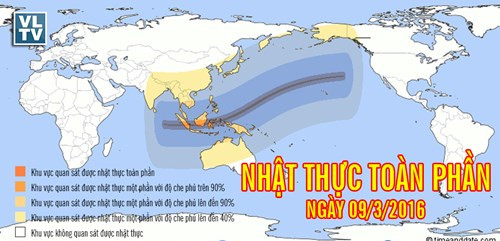Vietnam is about to see a solar eclipse
On March 9, Vietnamese astronomers will have a chance to admire a partial eclipse - the most anticipated astronomical phenomenon in 2016.
The total eclipse of March 9 has a route through central Indonesia and the Pacific, expected to start at 6:30 (local time) and last for a few minutes.Southeast Asia (including Vietnam) and northern Australia observed a partial eclipse. It is expected that this phenomenon will last from about 6h57 to 8h39 in Hanoi and from 6h35 and 8h41 in Ho Chi Minh City.
In Vietnam, all provinces and cities can observe partial eclipse with the maximum coverage of eclipse ranging from about 20% - 60% depending on the locality. Provinces and cities in the south have a larger coverage than the north. Ca Mau Cape has the largest maximum coverage, reaching nearly 60%.

Total eclipse.
The total solar eclipse is an amazing astronomical phenomenon, which occurs when the Moon completely obscures the Sun from the earth, revealing a beautiful outer atmosphere called the coronary ring.
However, direct eye eclipse observation can often cause permanent damage to the eyes so the observer must be very careful. Note that after observing an eclipse, it is not observed directly with the naked eye.
The observation of a solar eclipse with a sunglasses (black glasses), X-ray film, floppy bowel, video tape is not guaranteed because these types only reduce the brightness and not prevent harmful radiation. Observe an eclipse indirectly or use a dedicated filter such as a filter for a 14-digit welder or Sun filter from Astronomy Clubs.

The area can observe eclipse this time.(Source: vatlythienvan.com).
The observer can also use a cover to catch the image of the Sun through a small binocular or telescope, or cut a small round hole into the cover and observe the Sun's image through that hole in the face. land.
- When is the next solar eclipse in Vietnam?
- Vietnam did not observe the first solar eclipse of the year
- Tomorrow Vietnam will receive a solar eclipse
- Overview of solar eclipse this morning in Vietnam and Southeast Asian countries
- Where is the best eclipse on March 9 in Vietnam?
- See eclipse around the world
- Video: The coronary eclipse recommended in Australia
- Admire partial eclipse across Asia
- Vietnam welcomes the longest solar eclipse in 1,000 years this afternoon
- Reality and myths about solar eclipses
- The longest total eclipse of the century
- Partial eclipse across North America
 Vietnam 5th Asian champion on fuel-efficient vehicles
Vietnam 5th Asian champion on fuel-efficient vehicles We can read all NASA studies completely free of charge
We can read all NASA studies completely free of charge Singer and songwriter Bob Dylan won the 2016 Nobel Prize for Literature
Singer and songwriter Bob Dylan won the 2016 Nobel Prize for Literature Scientific revolution in Asia
Scientific revolution in Asia